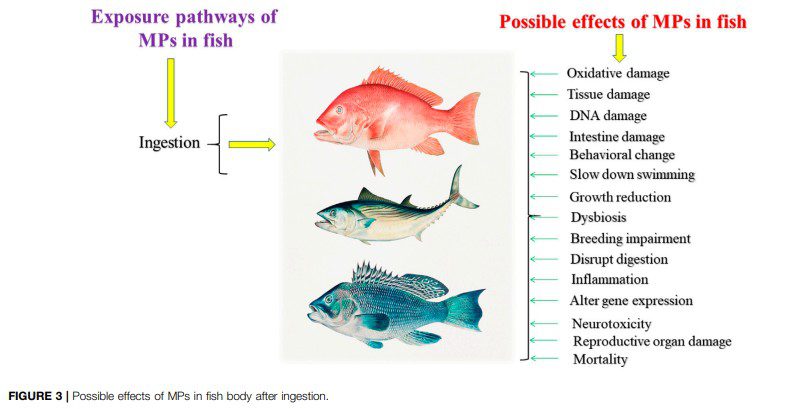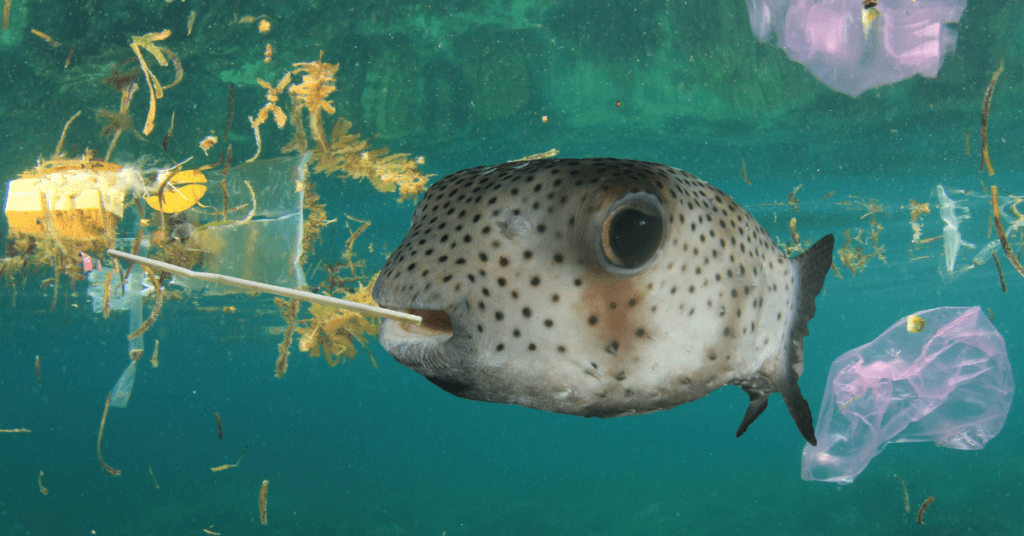Learn about how climate change impacts the concentration of microplastics in water bodies, and how this dramatically affects the ocean health, including nutrient cycles and oxygen concentrations in the ocean.
Climate change is a major global threat, affecting every region across the world, with increased ocean temperatures, sea-level rise, ocean acidification, and more frequent and extreme weather events causing widespread ecological and socioeconomic harm[1]. Although plastic pollution is often discussed separately from climate change, it is equally important to address. Marine plastic pollution is found in all regions of the ocean, from shallow coastal areas to remote and sensitive locations, and can compromise biological and anthropogenic systems and processes. Plastic production relies heavily on fossil fuel extraction and finite resources, and plastic waste has different contributions to global greenhouse gas emissions. Climate change currently influences the distribution of plastic pollution and will spread further with climate-driven increased extreme weather events and flooding.
HOW DOES CLIMATE CHANGE INCREASE THE CONCENTRATION OF MICROPLASTICS ?
Microplastics, small plastic particles that measure less than 5mm, are now being transported through the atmosphere in a way that is similar to biogeochemical cycles. Studies show that microplastics can travel over long distances to remote areas, and evidence is emerging of interconnectedness between the freshwater, terrestrial, and marine realms.[2]
Climate change has the potential to increase the concentration of plastic pollution in the global distribution of water bodies. For example, Arctic sea ice is a significant sink for microplastics, with densities ranging from 38 to 234 microplastic particles per cubic meter[3]. As warming temperatures continue to decrease the volume of sea ice, it will lead to the release of microplastics into the marine environment.
Moreover, climate change is already causing more frequent and intense extreme weather events, such as tropical storms, which can disperse mismanaged waste between terrestrial, freshwater, and marine environments. After a typhoon in Sanggou Bay, China, the abundance of microplastics increased by 40% within seawater and sediments.[4] Stronger winds, more frequent rain events, and sea-level rise can release plastics trapped in coastal sediments, increasing the risk of flooding and further inputs of terrestrial plastic into aquatic environments.
Flooding of global rivers due to climate change has the potential to worsen riverine plastic pollution, with flood risk areas often becoming sites with high plastic mobilization during flooding events.
IMPACTS ON NUTRIENT CYCLING AND OXYGEN CONTENT IN THE OCEAN
Microplastics in the ocean pose a threat to large marine mammals, fish, and seabirds, as they can mistake plastic objects for food. However, recent studies have shown that even tiny zooplankton can also ingest microplastics, which can have significant effects on the marine ecosystem.
Researchers at GEOMAR Helmholtz Centre for Ocean Research Kiel conducted a study that simulated how zooplankton that ingest microplastics could affect the base of the ocean food web and nutrient cycling. The study found that even low concentrations of microplastics can have a strong impact on ecosystems, affecting global nutrient cycling. The researchers found that if zooplankton replace some of their natural food with microplastics, it can have far-reaching ecological effects that can lead to increased algal blooms and a reduction in feeding pressure that affects the oxygen content of the oceans. Using an Earth system model to simulate how zooplankton that ingest microplastics could affect the base of the ocean food web and nutrient cycling, the researchers found that even low concentrations of microplastics can have a strong impact on ecosystems. This influence is already sufficient to affect global nutrient cycling, according to Dr. Karin Kvale, the lead author of the study.
The findings suggest that if zooplankton replace some of their natural food with microplastics, it can lead to increased algal blooms, which affects the oxygen content of the oceans almost as much as climate change.
The study’s findings point to a new potential driver of human-induced ocean change that has not been considered before. The results indicate that microplastic pollution can contribute to a loss of oxygen in the ocean beyond that caused by global warming. This is a significant concern as a loss of oxygen in the ocean can have severe consequences for marine life, affecting the growth, reproduction, and survival of many species.
The recent study conducted by researchers at GEOMAR Helmholtz Centre for Ocean Research Kiel highlights the need to address plastic pollution to ensure the health of the ocean ecosystem. However, it is crucial to address other threats such as climate change, overfishing, and nutrient pollution to ensure the long-term sustainability of the ocean ecosystem. We must take action to protect the ocean and its inhabitants, as it is essential for the health and well-being of our planet.[5]
The impact of climate change on plastic pollution is a significant concern that requires urgent attention. The transport of microplastics through the atmosphere and the interconnectedness of the different ecosystems present a complex challenge. However, by taking steps to reduce carbon emissions, addressing waste management practices, and developing sustainable solutions, we can work towards mitigating the harmful effects of climate change and plastic pollution.
IMPACTS ON MARINE LIFE
As they are ingested by marine species, microplastics can accumulate in their bodies, potentially causing severe harm. But how do fish react to the toxicity of microplastics?
Numerous studies have been conducted to investigate the impact of microplastics on marine life, including fish. Microplastics can cause harm to fish in different ways, depending on the nature of the microplastics after ingestion. Researchers have different categories of microplastics poisoning[6]:
- Build-up in the gastrointestinal tract: Microplastics can accumulate in the gastrointestinal tract of fish, causing physical harm such as blockage and damage.
- Release as pseudofeces: Fish may expel microplastics as pseudofeces, which can disrupt their energy transfer.
- Transfer inside the body: Microplastics may also transfer inside the body of fish, exposing their inner organs and tissues to the harmful particles.

Studies have shown that microplastics pose a significant threat to fish, with mortality occurring frequently before they reach maturity due to microplastics intake. The most common effects of microplastics in fish include oxidative stress, decreased mobility, gene expression disruption, and damage to reproductive organs.
The Danio rerio, also known as the zebrafish, is the most commonly studied fish regarding microplastics exposure. Researchers have found that microplastics ingestion by the Danio rerio can lead to oxidative stress, decreased mobility, gene expression disruption, and damage to reproductive organs.
Other fish, such as Oryzias melastigma and Sparus aurata, have also been found to be affected by microplastics ingestion[7]. Oryzias melastigma faces growth inhibition, dysbiosis of fish gut, reduction of weight, disturbance of anti-oxidative condition of the liver, damaging reproductive organs and growth retardation. Sparus aurata, another important consumable fish, may experience stress, oxidative damage, survival, behavior changes, and damage to the immune system’s key functions.
An increasing proportion of animals living in or feeding on the sea end up ingesting plastic – already over 40% of species of marine birds and mammals. This situation is worrying scientists, NGOs, and, more recently, politics.[8]
Pieces of plastic can directly injure organs, create inflammations, or block breathing or digestion. For microplastics, scientists suspect short or medium-term negative effects: By giving a false impression of satiety, they could cut hunger and prevent sufficient intake of nutritional elements. Some chemical additives could be toxic, including disrupting the hormonal system. Nanoparticles, below one-thousandth of a millimeter, could enter cells or pass into the brain, with still unknown effects.[9]
Scientists have found out that microplastics passing through water treatment plants could promote the development of bacteria, including antibiotic-resistant ones. This is just one example of the multitude of possible effects.[10]
A SOLUTION IS NEEDED URGENTLY
The impact of plastic pollution on marine and aquatic wildlife is becoming increasingly concerning, and action must be taken to reduce our plastic consumption and properly dispose of plastic waste. Governments, businesses, and individuals all have a role to play in protecting our oceans and the diverse species.
Ascandra provides a viable solution to the growing problem of microplastic pollution in our oceans. By creating a protective shield zone through the cleaning of our coasts and rivers, this ultra-compact water filtration system effectively isolates and concentrates floating microplastics up to a million-fold, preventing them from entering our oceans. With the ability to collect microplastics down to a tenth of a millimeter at 1m3 per minute, Ascandra offers a high-tech and effective solution to this global issue. It is crucial that we start using innovative solutions such as Ascandra to remediate the microplastics problem, protecting not only our marine life but also ourselves and our planet.
References
[1] Napper, I.E., Davies, B.F.R., Clifford, H., Elvin, S., Koldewey, H.J., Mayewski, P.A.,Miner, K.R., Potocki,M., Elmore, A.C., Gajurel, A.P., Thompson, R.C., Reaching new heights in plastic pollution—preliminary findings of microplastics on Mount Everest. One Earth 3, (2020)
[2] Stubbins, A., Law, K.L.,Muñoz, S.E., Bianchi, T.S., Zhu, L., 2021. Plastics in the Earth system. (2021)
[3] Obbard, R.W., Sadri, S., Wong, Y.Q., Khitun, A.A., Baker, I., Thompson, R.C., Global warming releases microplastic legacy frozen in Arctic Sea ice. Earth’s Future 2, (2014)
[4] Wang J, Lu L, Wang M, Jiang T, Liu X, Ru S. Typhoons increase the abundance of microplastics in the marine environment and cultured organisms: A case study in Sanggou Bay, China. Sci Total Environ. 2019)
[5] https://www.sciencedaily.com/releases/2021/04/210421124552.htm
[6] Zhang, X., Xia, M., Zhao, J., Cao, Z., Zou, W., and Zhou, Q. Photoaging Enhanced the Adverse Effects of Polyamide MPs on the Growth, Intestinal Health, and Lipid Absorption in Developing Zebrafish. Environ. Int. 158 (2022)
[7] Wang, J., Li, X., Gao, M., Li, X., Zhao, L., and Ru, S.. Polystyrene MPs Increase Estrogenic Effects of 17α-Ethynylestradiol on Male marine Medaka (Oryzias Melastigma). Chemosphere 287, (2022)
[8] Ellen MacArthur Foundation. The New Plastics Economy: Rethinking the Future of Plastics. (2016).
[9] Environmental and Health Risks of Microplastic Pollution Scientific Opinion. Group of Chief Scientific Advisors European Commission Directorate-General for Research and Innovation. (2019).
[10] Wright, S. L., Kelly, F. J., & Hood, C. Plastic and human health: A micro issue? Environmental Science & Technology, 54 (2017)

Nour Chebbi
Head Of Marketing
M.Sc. Microfluidics

